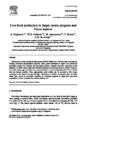Live food production in Japan: recent progress and future aspects

Tingnan/Open
Petsa
2001Page views
296Metadata
Ipakita ang buong tala ng itemCited times in Scopus
158 readers on Mendeley
Share
Abstract
Techniques to culture rotifers at high-density (2000 to 20 000 ind./ml) have been developed by utilizing condensed phytoplankton products. Many public hatcheries in Japan have introduced automated systems for culturing and harvesting rotifers. Research has been conducted on the diagnosis of rotifer culture status and chemical treatment for reducing stress on rotifers. Preservation of the resting eggs of rotifers for an extended period or at low temperature (4 °C) for a limited time has become possible. Thus, appropriately sized rotifers can be provided to fish larvae, according to fish species and growth stage. Techniques to identify the genetic status of rotifer strains have yet to be developed. Practices for culturing copepods in Japan have also been summarized.
Suggested Citation
Hagiwara, A., Gallardo, W. G., Assavaaree, M., Kotani, T., & de Araujo, A. B. (2001). Live food production in Japan: recent progress and future aspects. Aquaculture , 200(1-2), 111-127. https://doi.org/10.1016/S0044-8486(01)00696-2
Paksa
Mga koleksyon
- AQD Journal Articles [1248]
